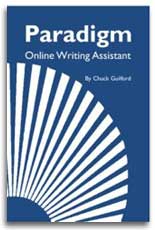Unlike pyramid charts and cluster maps, which can show complex organizational relationships in a single glance, your writing itself is sequential. Readers don't encounter your ideas all at once but one after another.
Readers don't encounter your ideas all at once, but one after another.
Keeping this in mind, you need to consider how best to order your discussion and how to provide signposts that help readers locate themselves and see where they're headed.
Create Expectations
Often this involves little more than forecasting or predicting where the discussion will go. If you tell readers that you'll cover four points, they'll expect you to do so, and to cover those points in the order you list them. If you honor your commitment by satisfying these expectations, readers will perceive your writing to be organized.
You can forecast on the level of the essay as a whole or on the sentence and paragraph levels. Doing so not only helps readers see where you're headed, it can help set you up as a writer, so you know where you're headed and how close you are to your destination.
In fact, you may find it helpful to think of yourself as a tour guide telling readers what they can expect to encounter both on the trip as a whole and at each stop along the way
Consider a Strategy of Disclosure
You may not always want to give away your whole plan at the beginning. You may want readers to feel some suspense and anticipation about where the discussion is heading. If so, you may want to hint at what lies ahead but to withhold some details, enticing readers to keep moving forward in order to have their curiosity satisfied.
Such an approach can be quite effective, partly because it piques reader interest, but also because it forces you to carefully consider possible reader response. If you give away too much, you'll break the suspense. If you give away too little, readers may lose the thread you want them to follow.
You need to ask yourself how much information and what kind of information your readers need to have at each step of the discussion. In the end, readers should feel that their expectations have been satisfied.




